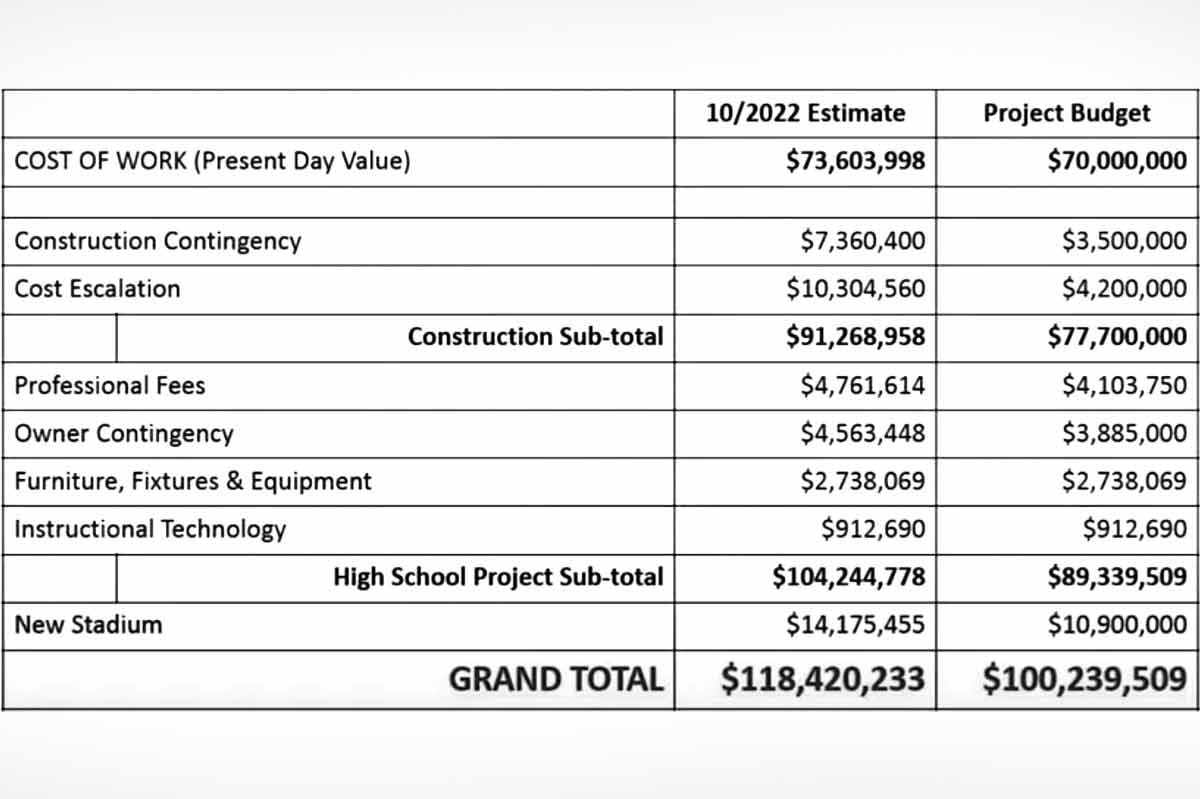Franklin High project moves forward

Progress will continue on the new Franklin High School after a vote by the Macon County Commission to enter into phase two of the project.
“We’ve just kicked this can for so long, I’m ready to vote it up or down,” said Commissioner Josh Young, who instigated the motion to move forward with the project.
At a budget work session in February, Paul Boney and Emily Kite of LS3P Designs presented commissioners with an update on the project. The timeline now shows construction documents and procurement for phase one — involving stadium construction — will take place between March and October of this year, after which construction will begin and is set to last around 14 months. Construction of the stadium portion of the project is estimated to wrap up in January 2025.
Design development for phase two — involving construction of the high school — will run through June, construction documents and procurement are estimated to take until the end of this year with construction running from January, 2024 through June, 2026.
“We have the flexibility to run the stadium project and the high school project not quite on the exact same track,” said Kite. “We’re a little bit ahead in our development of the stadium, we’re a little further along on that particular project.”
There is also flexibility within the stadium portion of the project depending on whether Franklin High School can schedule an entire season of away football games. If so, construction on the stadium can begin in the fall, otherwise it will begin afterward.
Related Items
The construction subtotal for the project was originally estimated at $91.2 million and is now estimated at $77.7 million.
“Originally in the estimate we had over $10 million for cost escalation. In this estimate we’ve cut that to about $4.2 because if we’re going from right now to September to bid this thing, then that cost escalation window for us is much less,” Boney said.
At the Feb. 9 meeting, Young made a motion to authorize LS3P to enter into phase two design development for Franklin High School, which will allow for construction documents and procurement for the stadium portion of the project. To move into this phase of the project the motion also included the allocation of $715,120 from the general fund.
The $715,120 appropriated from the general fund, along with the $335,122 already spent, gets the county to the $1 million commitment necessary for the design development of the new high school and the construction documentation and procurement for the new stadium.
“This is going to get us to where we need to get to put the budgeting together for the whole project,” said Young. “Right now, we can’t bid this thing out. These numbers are all estimates, we don’t even know what it costs.”
The motion passed unanimously. Throughout the rest of the year, county government and the school system will start to see a clearer picture of actual project costs as individual pieces get estimated and go to bid.
“This will take the stadium portion through procurement, which is putting it out to bid and getting prices back,” said County Manager Derek Roland.
This vote not only moves the high school project forward, it also helps the design firm and the school system complete its grant application for the needs based capital improvement funding available through the state.
“It gets us through design development, which allows us to get all of our engineers involved, allows us to get the building settled, the size of the building settled. It allows us to go back to the public and make those presentations,” said Boney. “Then we have construction documents to go, which takes about another four or five months’ worth of work, in order to get it ready to bid. But we would have submitted design development to school planning so that they know we’re serious about this project.”
During the budget work session, Mitch Brigulio of Davenport Public Finance, the county’s financial advisor, presented commissioners with the overall financial state of the county, as it relates to the county’s credit rating and its ability to borrow money. According to Brigulio the county has a double A rating, two spots from the highest public rating possible.
“You’re starting from a position of strength in terms of your credit rating,” he said. “You have access to the capital markets, and you have access to borrow money and you can borrow that money at an attractive rate based on your credit rating.”
With a particularly plentiful fund balance available, Brigulio presented two options for fund the high school project — one in which the county does not receive any grant funding, and the other in which the county receives $50 million in needs-based grants from the state.
If the county does not receive grant funding, it will need to issue $14 million in debt 2024, and $102 million in debt in 2025. This would require an additional 4.5 cents on the current property tax rate to cover the debt service. If the county does receive grant funding, it would need to issue $14 million in debt in 2024 and $54 million in debt in 2025. This scenario would require an additional 1.17 cents on the current property tax rate to cover the debt service.
While voters chose not to pass the article 46 sales tax referendum last November, the proceeds of which would have gone toward building the new school, it could still do so in the future. If the county were to succeed in passing the article 46 sales tax referendum, it would only need an additional 2.8 cents in property tax for the no-grant scenario; it would need no tax increase in the case that it does receive grants.









